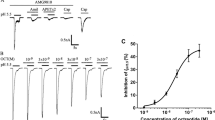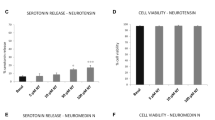Abstract.
The putative anti-inflammatory and anti-nociceptive activity of the heptapeptide somatostatin analogue TT-232 (D-Phe-Cys-Tyr-D-Thr-Lys-Cys-Thr-NH2) was investigated in the rat and mouse, as well as its effect on neuropathic hyperalgesia, gastric ulceration and the release of sensory neuropeptides. In the rat, carrageenin-induced paw oedema was inhibited dose dependently by TT-232 (3×2.5–20 µg/kg i.v.). Evans blue accumulation induced by intraarticular bradykinin injection (0.5 nmol in 0.1 ml) was slightly, but significantly inhibited by a single TT-232 dose (5–20 µg/kg). Cutaneous neutrophil accumulation over a 3-h period after intradermal (i.d.) injection of carrageenin (1 mg/site) or interleukin 1β (IL-1β, 3 pmol/site) was inhibited significantly by TT-232 (3×80 µg/kg i.v.), while diclofenac (3×10 mg/kg i.v.) elicited significant inhibition only in the IL-1β test. In the mouse, TT-232 potently decreased oedema formation induced by 2.5% capsaicin applied topically to the ear. Mechano-nociception in the rat hind-paw during neuropathic pain induced by partial sciatic nerve injury (model of Seltzer) was measured using the Randall-Selitto test. TT-232 (5–20 µg/kg i.p. on the 7th day after the operation) dose-dependently inhibited the mechano-nociceptive hyperalgesia. In vitro release of substance P (SP), calcitonin gene-related peptide (CGRP) and somatostatin from the isolated rat trachea in response to electrical field stimulation (40 V, 0.1 ms, 10 Hz, 120 s) of its nervous elements was inhibited significantly by 500 nM TT-232. The role of G protein-coupled receptors in the effect of TT-232 was indicated by the prevention of its inhibitory action on the release of sensory neuropeptides by incubation the tissue for 1 or 6 h with pertussis toxin (100 ng/ml). The release of sensory neuropeptides to in response to electrical nerve stimulation was not inhibited by a potent tyrosine kinase inhibitor, genistein (50 µM). TT-232 (up to 5 mg/kg i.p.) did not induce mucosal lesions in either the stomach or the duodenum.
These data suggest that TT-232, a somatostatin analogue devoid of endocrine effects, is a promising lead molecule in the search for novel, broad-spectrum anti-inflammatory and analgesic agents.
Similar content being viewed by others
Author information
Authors and Affiliations
Additional information
Electronic Publication
Rights and permissions
About this article
Cite this article
Pintér, E., Helyes, Z., Németh, J. et al. Pharmacological characterisation of the somatostatin analogue TT-232: effects on neurogenic and non-neurogenic inflammation and neuropathic hyperalgesia. Naunyn-Schmiedeberg's Arch Pharmacol 366, 142–150 (2002). https://doi.org/10.1007/s00210-002-0563-9
Received:
Accepted:
Issue Date:
DOI: https://doi.org/10.1007/s00210-002-0563-9




